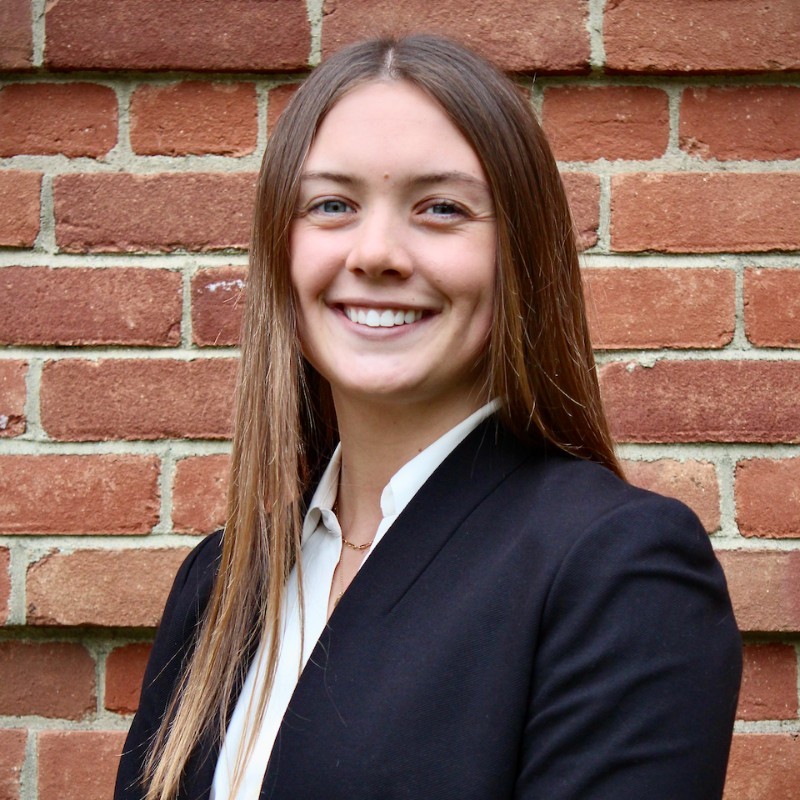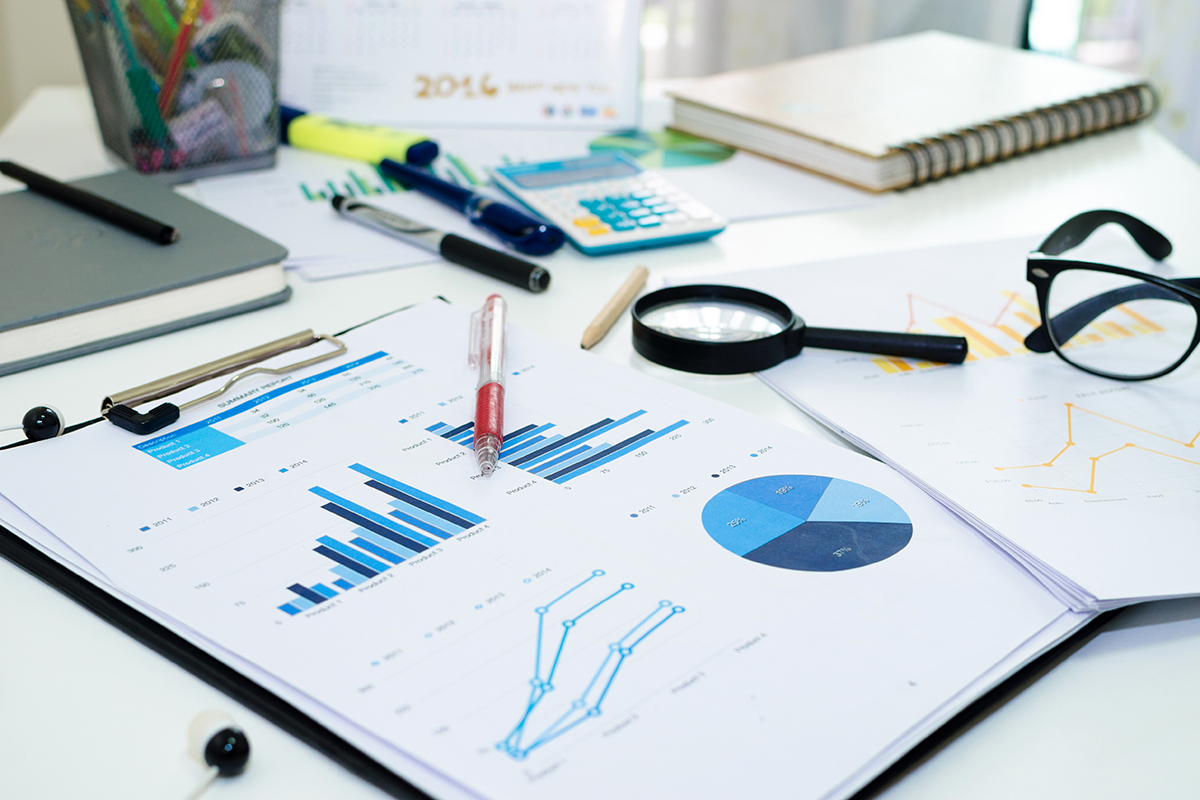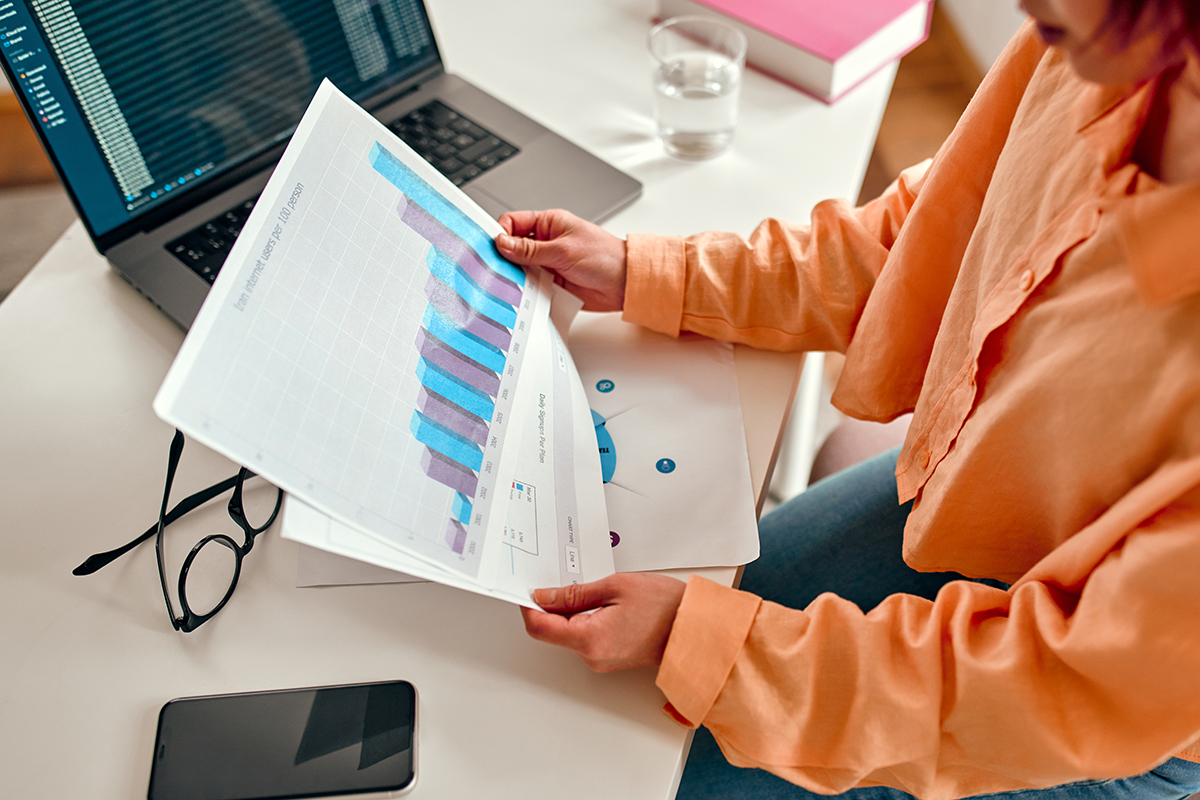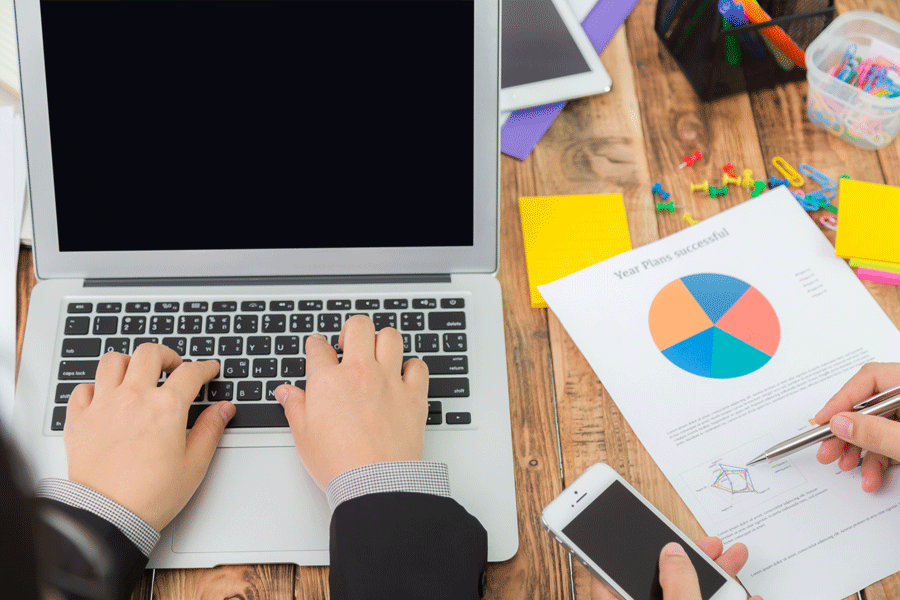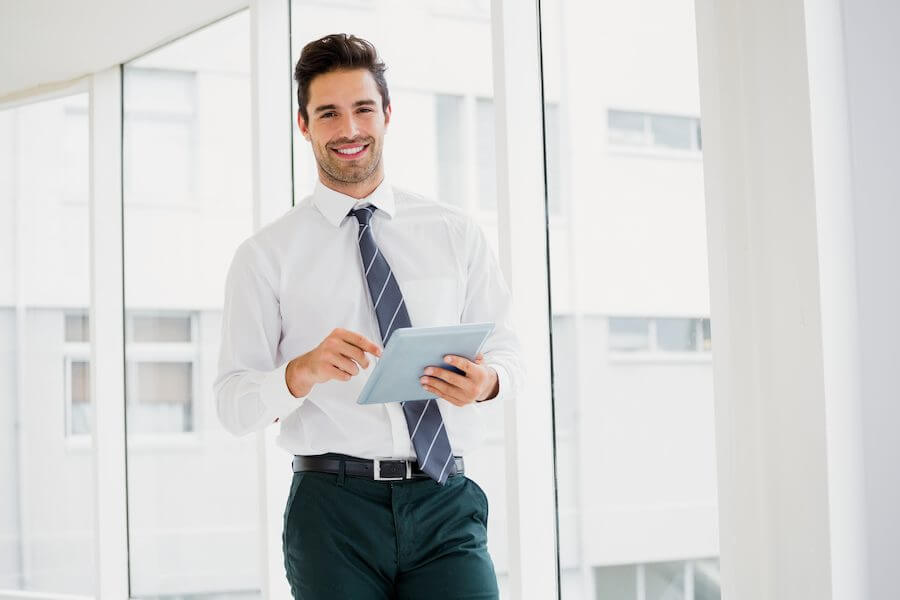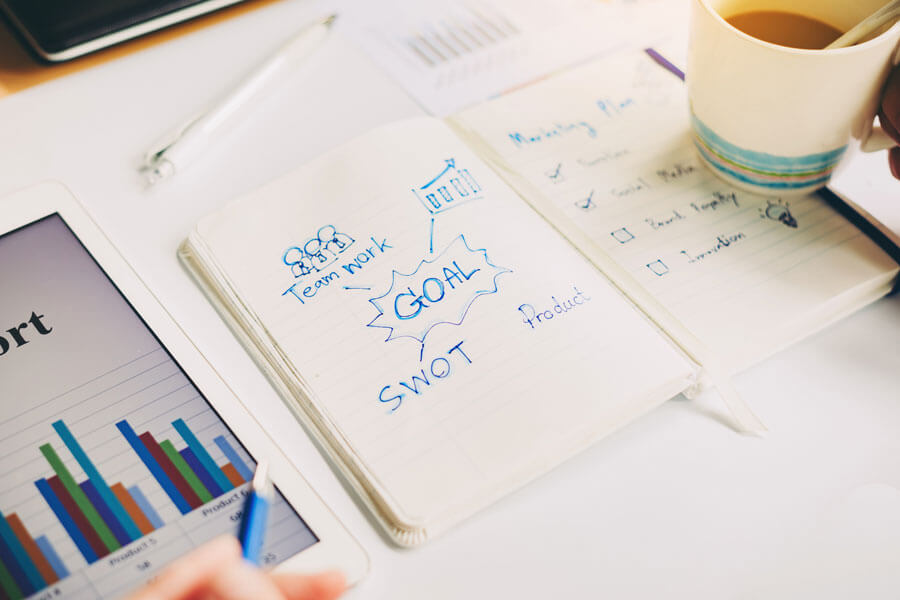A self-evaluation is the process of employees assessing their own strengths and weaknesses and, at the same time, judging the quality of their work over a given period.
Employees are expected to update their employers on their successes and failures within the organization for a given period, usually one year. Employees reflect on how well they are equipped to carry out their jobs and discuss their shortcomings in the workplace. If done right, a self-evaluation can boost your chances of progressing career-wise, for example, through a promotion or getting benefits.
It is also referred to as self-assessment or self-appraisal.
Self-assessments are not limited to performance; an employee can evaluate their personality to illustrate what they are good at and what they are not good at. However, in a business setting, it is best to evaluate yourself strictly as an employee because employers are primarily interested in your performance and your contribution to the organization or company. The aspects of assessment include performance at work, completion of tasks and projects, time management skills, adhering to policies, communication skills, etc.
Self-Evaluation Templates: Types
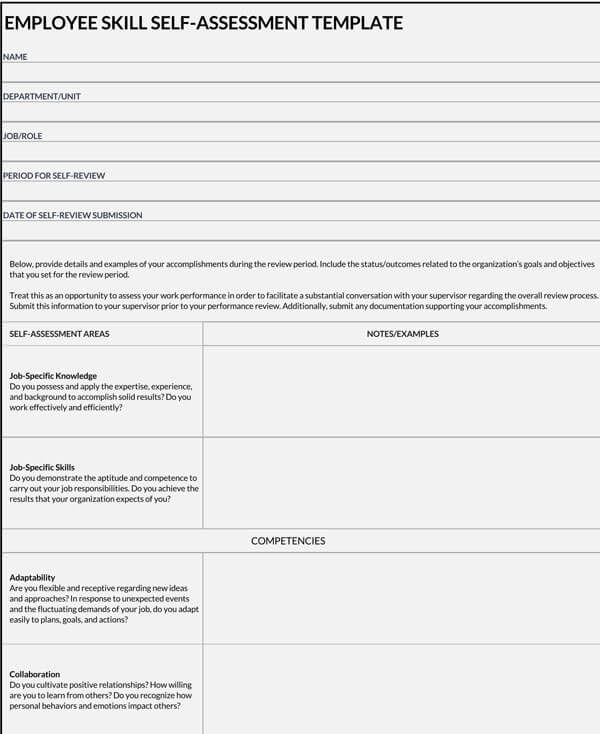
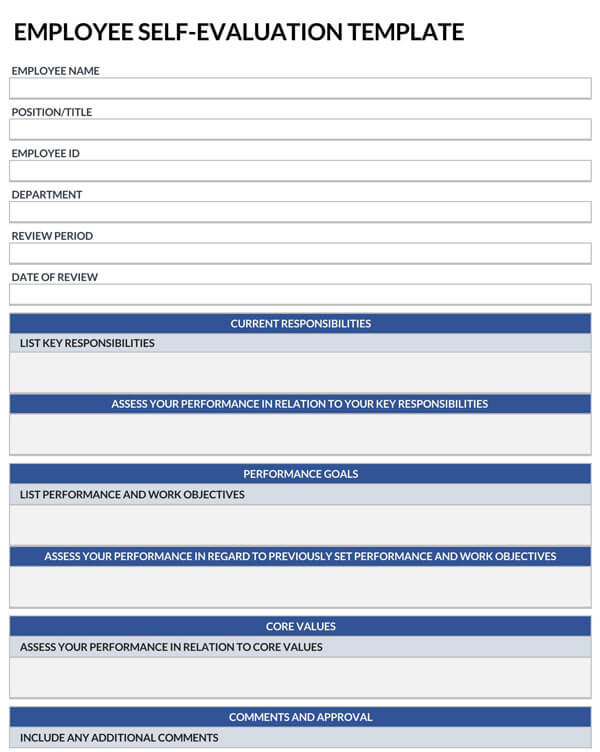
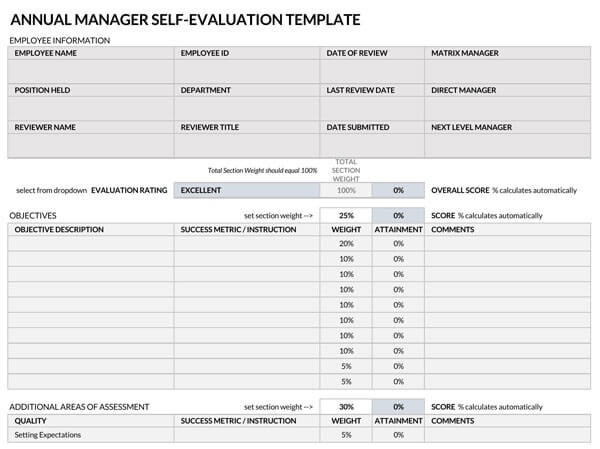
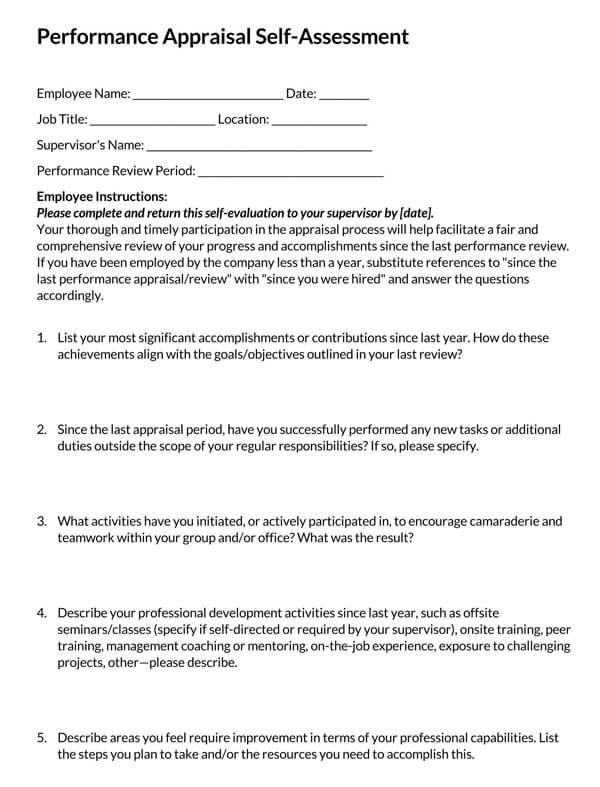
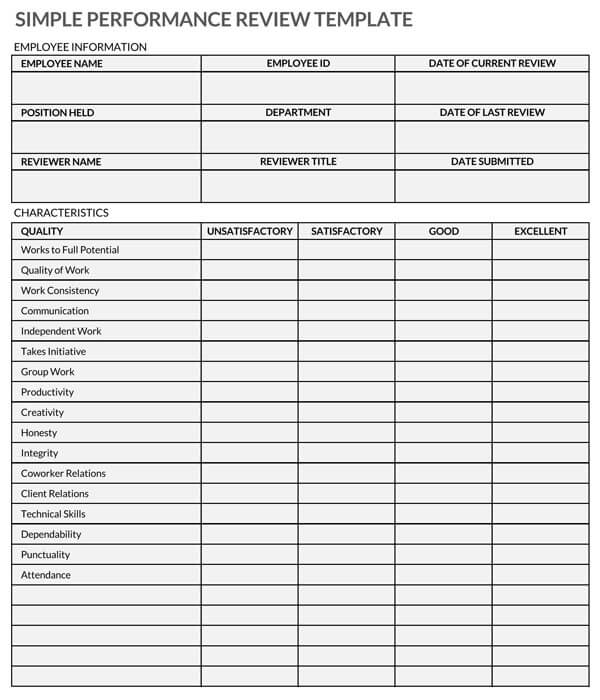


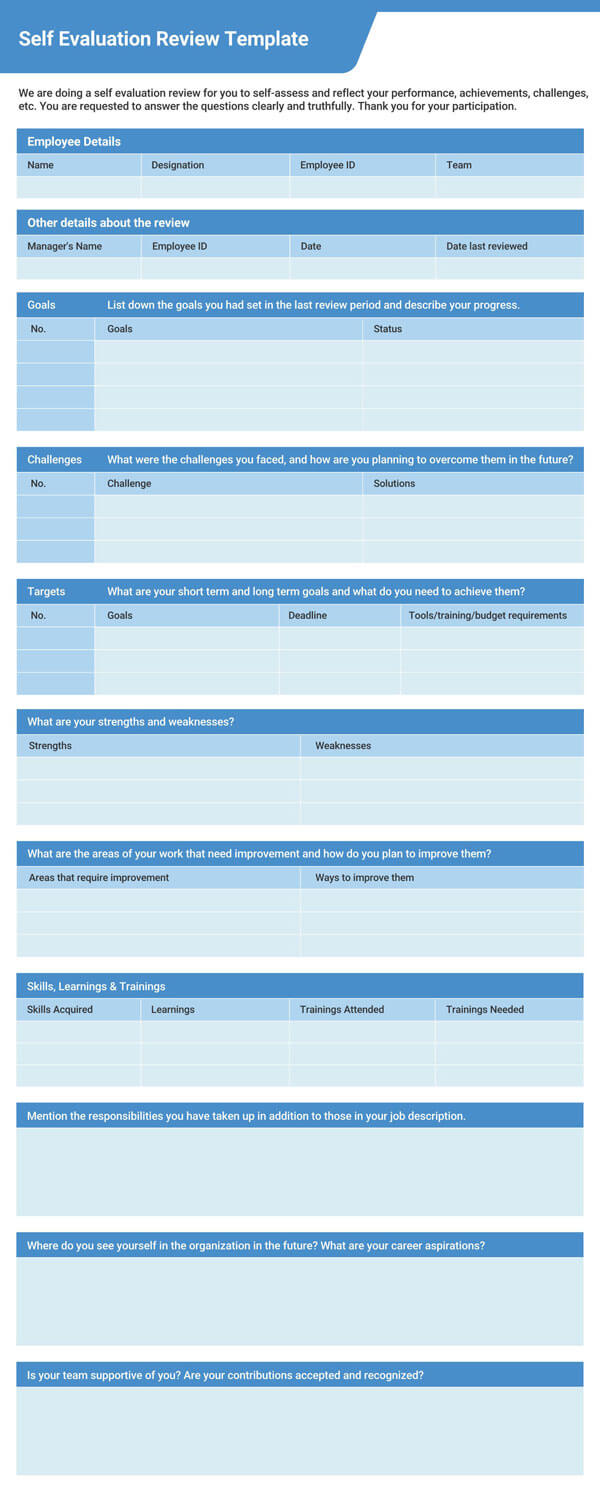


Importance of Self-Evaluation
Self-assessment is a common and vital practice in the corporate world. As opposed to what many employees think, it is not a waste of time. Employers use it for various management purposes. In addition, it is not beneficial to the employer alone; employees also benefit from writing self-assessment reports.
Below are some reasons why employees should consider writing a self-evaluation report and how it applies in a business setting.
- Allows employees to show their accomplishments: Through a self-assessment, an employee is able to take note of things they have been able to achieve in the organization within the year. With a busy schedule throughout the year, it is hard to keep track of what has been achieved. A self-review is an effective way for employees to take time to remind themselves of any projects they were involved in and their contribution to the organization.
- Helps the manager stay informed: It is an opportunity for the employee to let their employers know their progress on tasks and assigned projects. When writing the report, employees are allowed to include challenges and/or hindrances to accomplishing goals set at the beginning of the year. This way, managers (employers) remain informed of the on-goings of their employees.
Also, it lets the manager know about the challenges that an employee has faced during the year. A manager can see the potential candidate for the company. It is important to be in the good books of the managers. They should know how much effort an employee is putting in. The performance output should reflect the success and growth of an employee. - Motivate employees: Sometimes it is easy to believe that you are not doing enough at the workplace. A self-assessment is a chance to put these doubts to rest. It highlights the success or progress an employee has made toward their employment goals. This can be motivation to either work harder or assurance that you are indeed doing enough. A self-review can also help point out where to improve as an employee.
- Helps to know the expectations: Apart from all this, with the help of a self-evaluation, an employee gets an idea of the difference of opinion between himself or herself and the manager. Not every person has the same thinking process. It is necessary to know what a manager thinks of the employee and what the employee thinks of his or her performance. It is possible to match the thoughts with the help of these documents and that is why it is extremely crucial for success and growth.
- Helps to quantify employee’s value: When discussing performance, an employee is able to quantify their contribution to the organization using figures such as numbers, percentages, and such.
EXAMPLE
Their influence on percentage sales, etc. When an employee’s value is quantified, employers can base their decision to promote, raise salaries, and prolong contracts on it
- Helps in employee branding: A manager can remember the details through the self-evaluation of an employee. It is practically quite difficult to remember the details of each employee working for a particular company. It is like the branding of that particular employee. It depends on how much an employee has been able to present himself or herself nicely on a simple piece of paper.
Therefore, it is wise to have a self-evaluation in order to make progress in personal growth and be a successful employee of the company.
5 Reasons to Conduct a Self-Evaluation
The main reason for self-evaluation is to get an idea of the critical picture of the overall performance.
- An employee would know where they stand in terms of their overall performance in the company.
- It can guide an employee to perform better in a particular section.
- It can help an employee reflect on the past 12 months of their performance.
- An employee would know about their strengths and could use them in the right direction.
- An employee can know about their weaknesses and do something to overcome them.
Free Templates
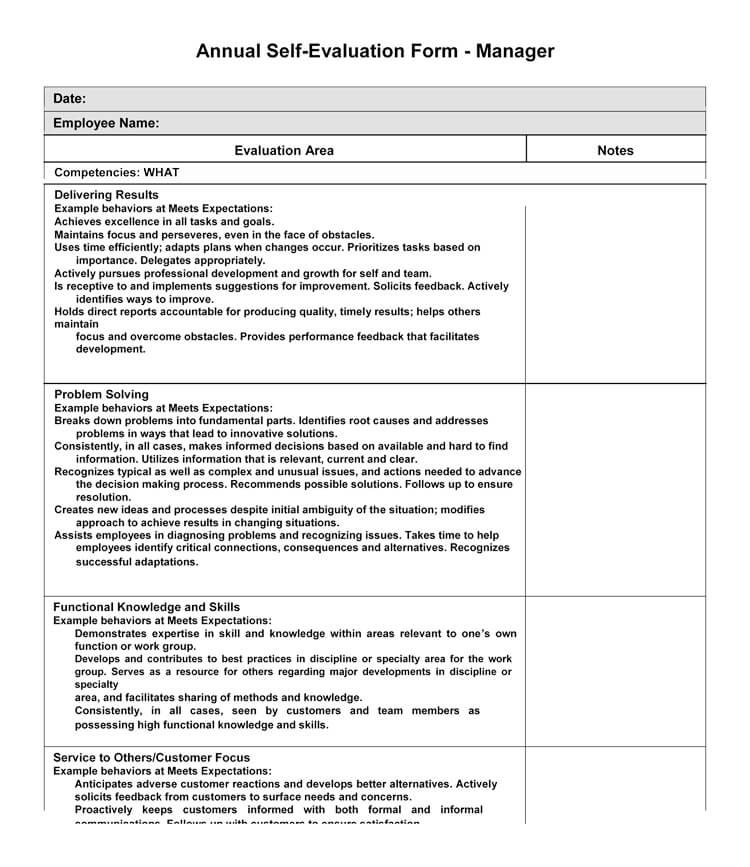

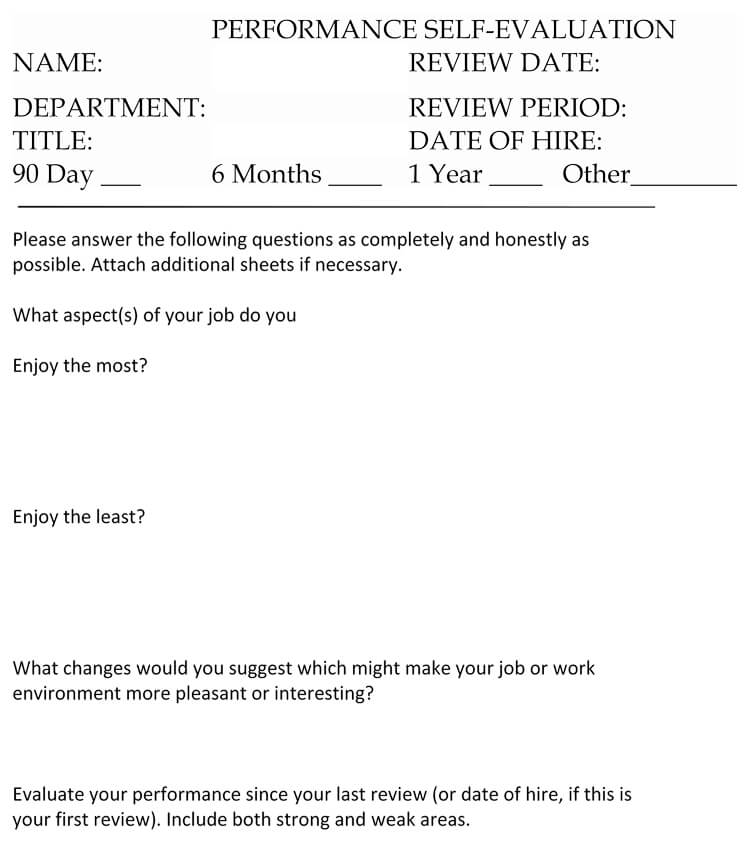
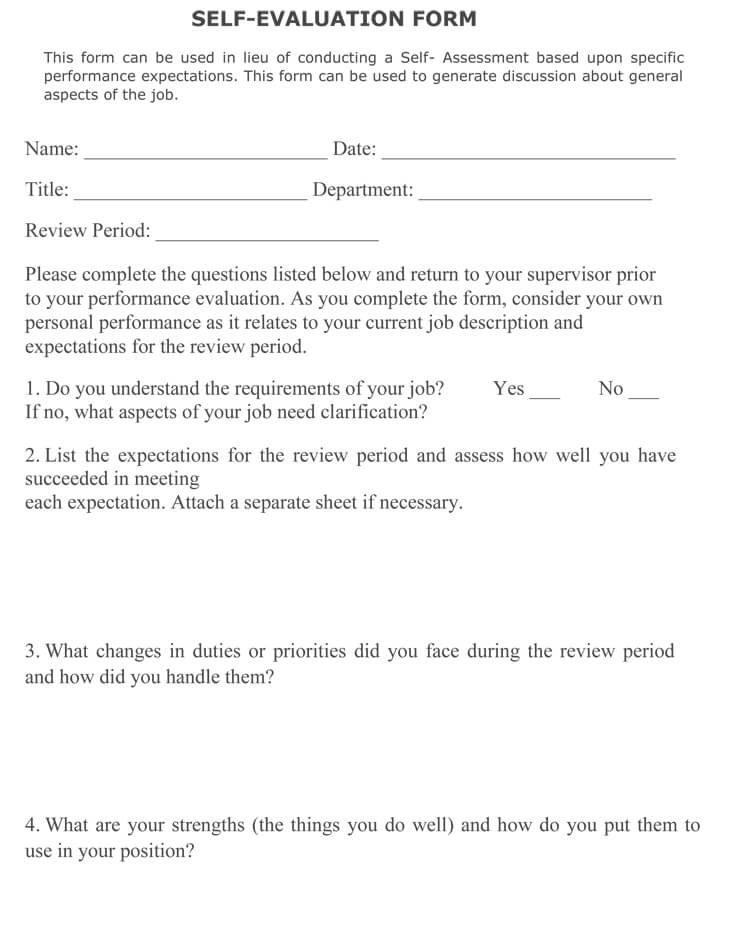



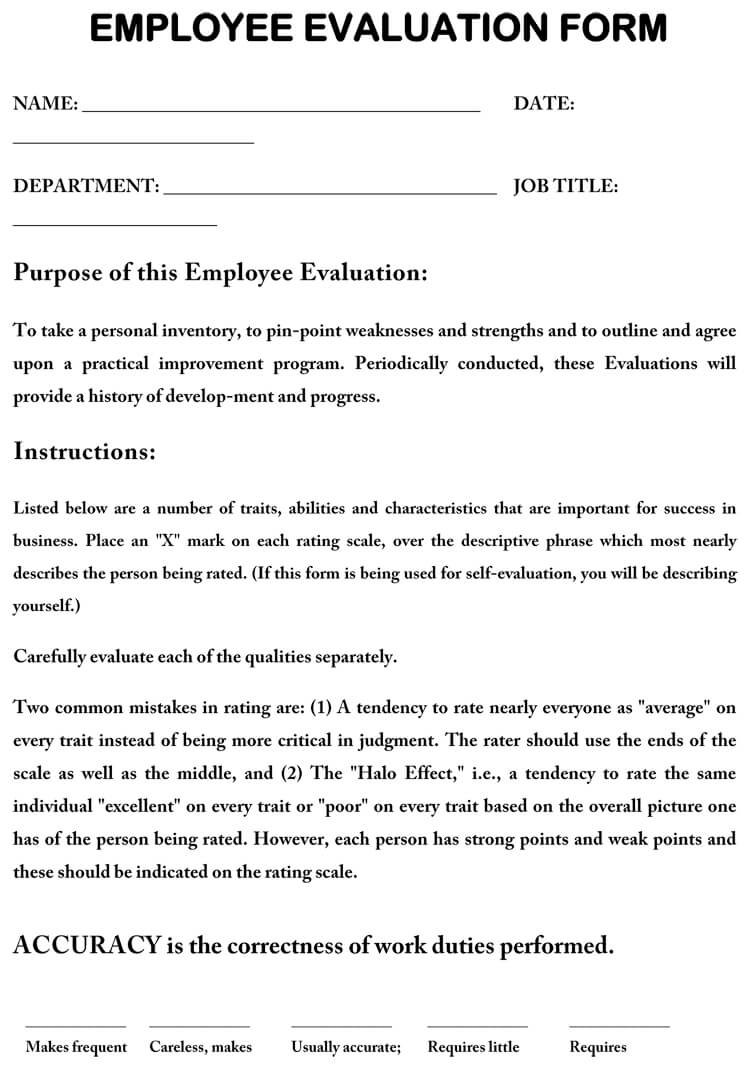

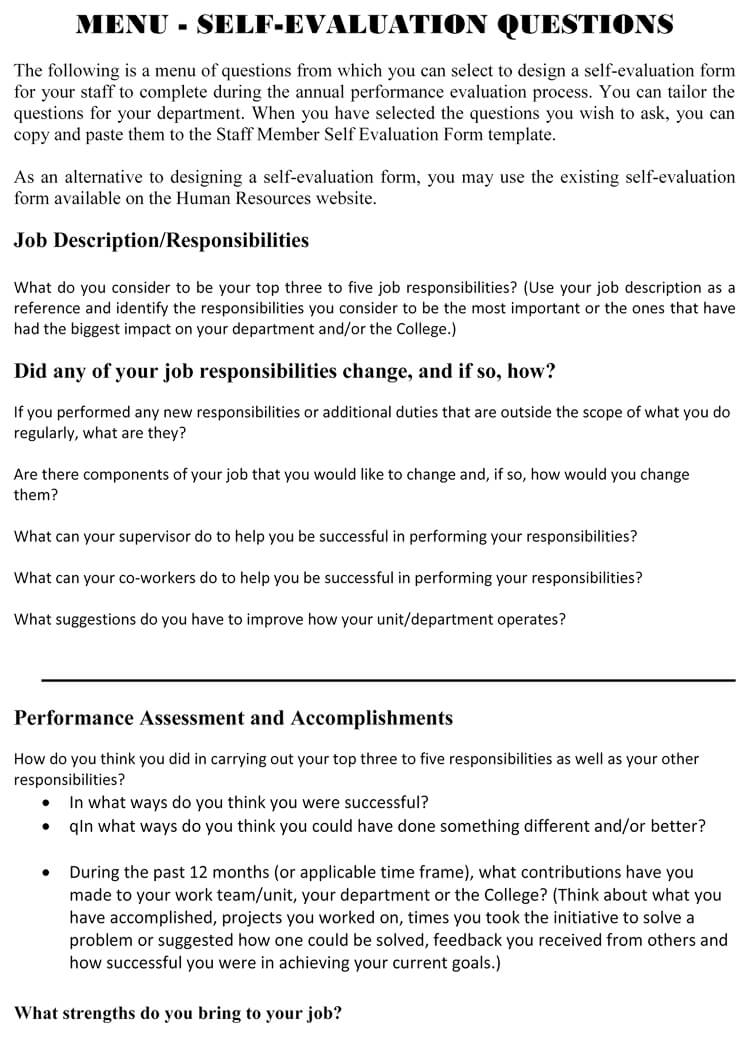

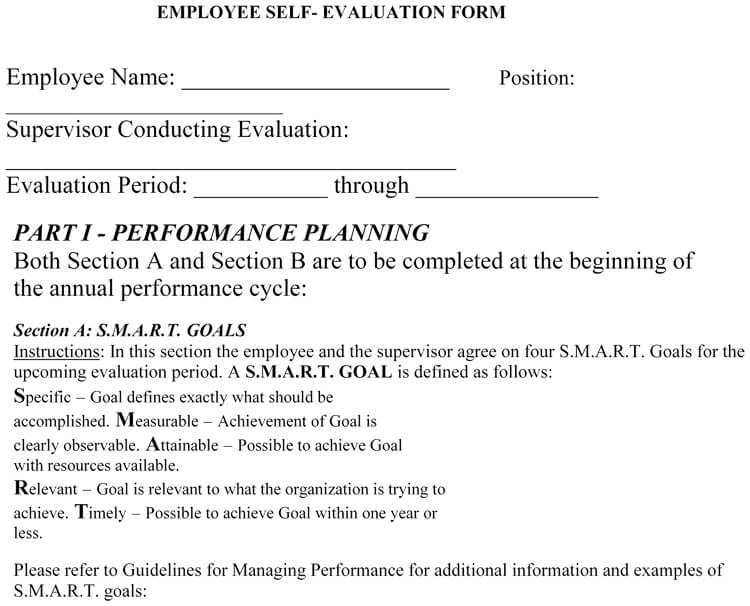
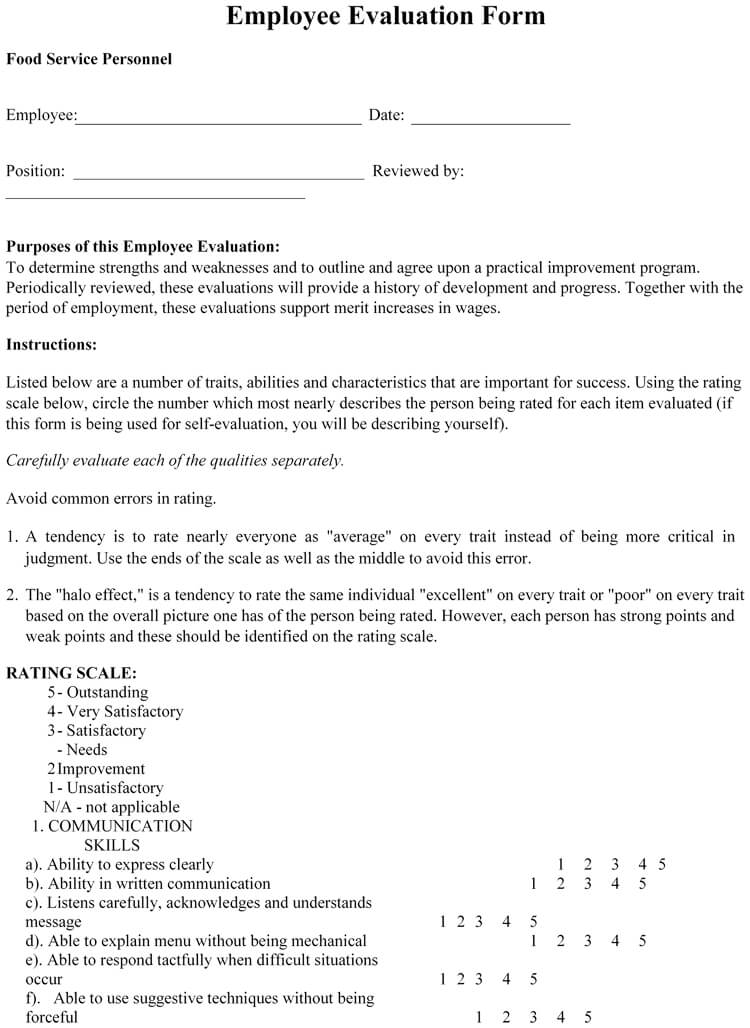

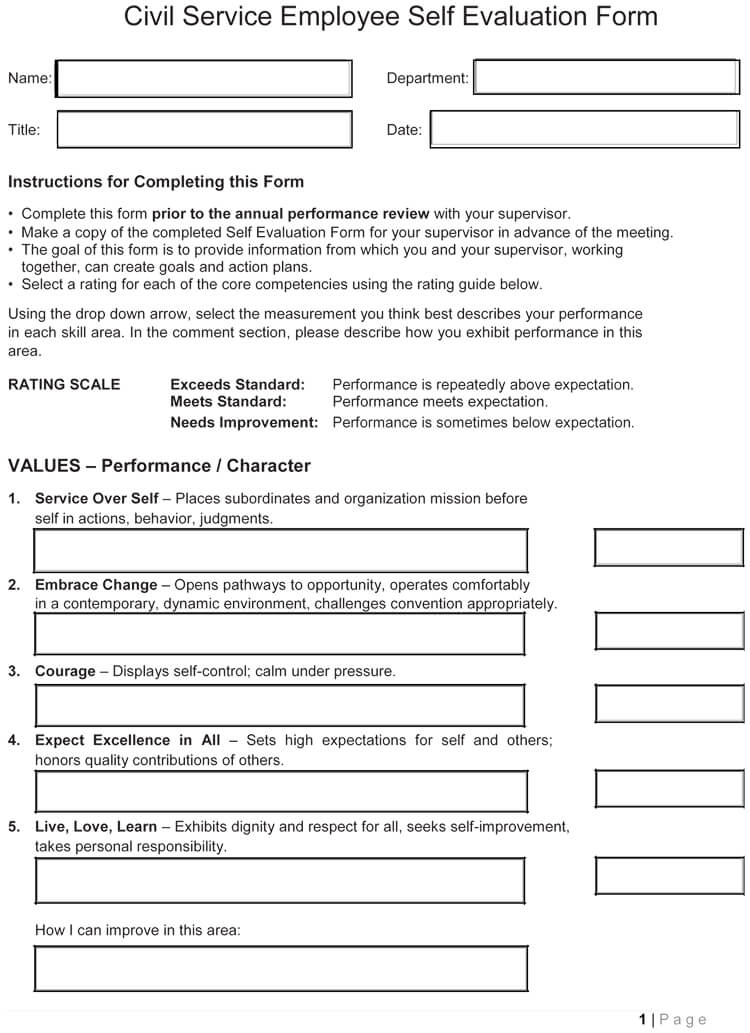
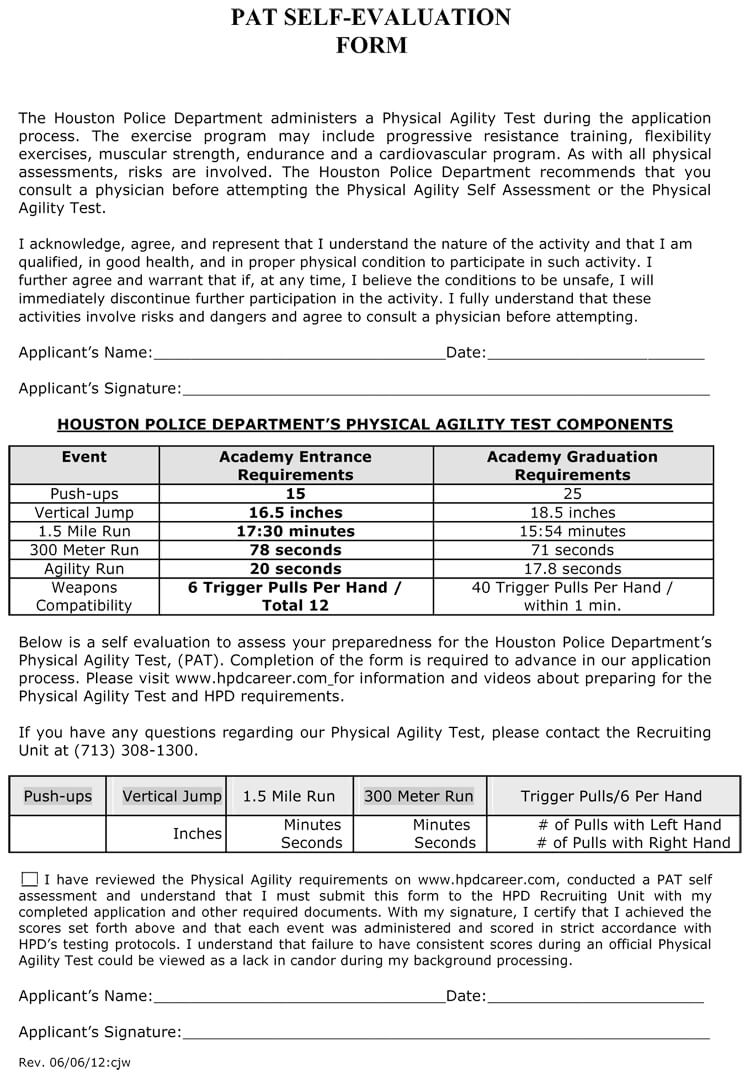
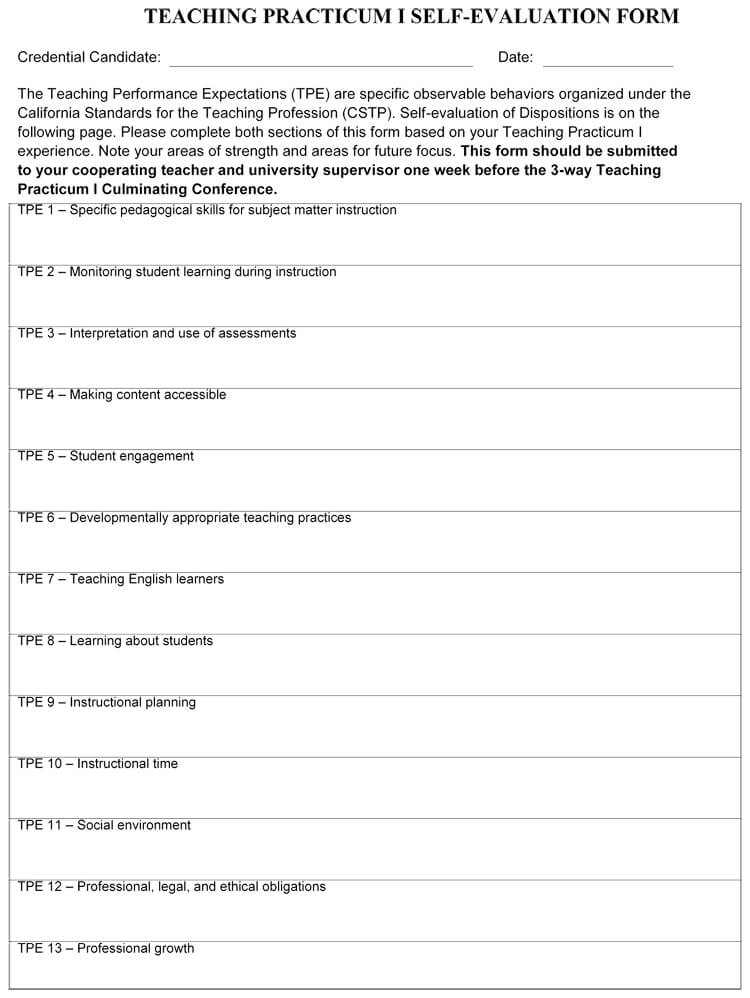

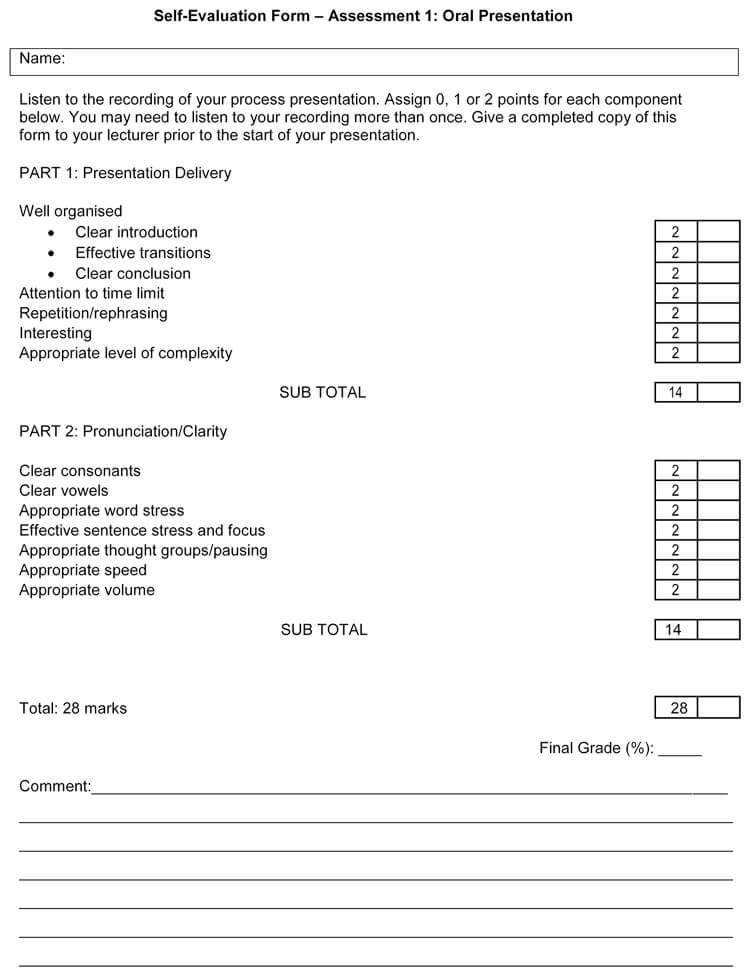
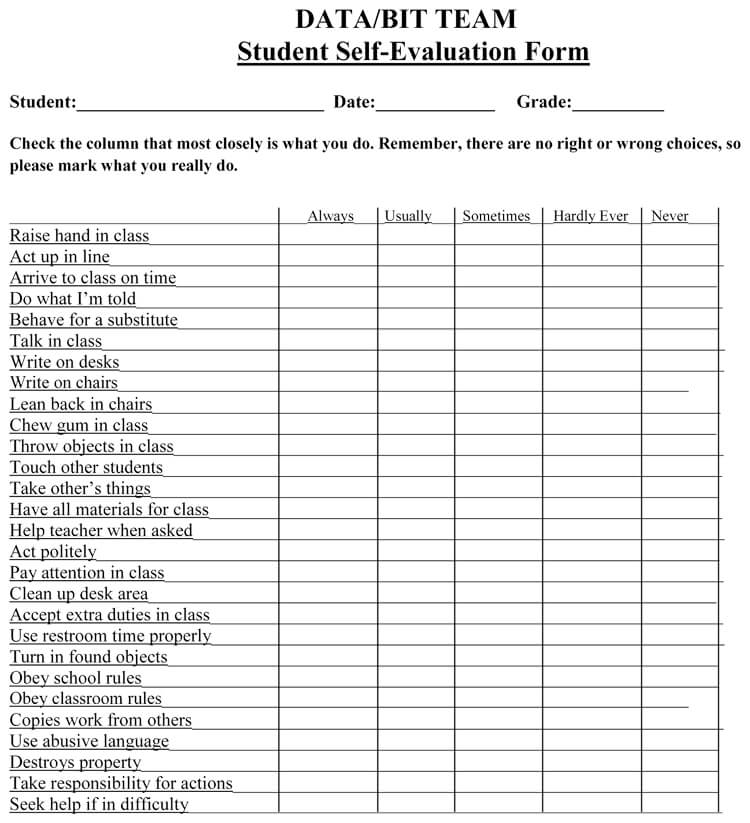

List the Positive Traits before Writing
The first thing an employee should do is determine if there are any positive traits he or she has that are impactful at their workplace. This is inclusive of special skill sets and professional skills.
You should make a list and indicate how they use them in the workplace. Some of the common traits fall into the following categories:
Communication
The employee should consider their written and verbal communication skills when evaluating their communication ability. Effective communication is crucial in the workplace.
You can use a phrase such as:
EXAMPLE
I am a firm believer in open conversations and positive criticism when addressing problems and challenges in any setting. I have introduced such a communication culture in the HR department, which has led to faster resolution of in-house issues.
Performance
Performance is a key component of self-evaluation. Employees should demonstrate how they are able to carry out their duties and responsibilities as assigned to them.
EXAMPLE
I completed tasks given to me by my supervisors on time. I’m a quality-driven employee and always focus on meeting the company’s standards for any work-related obligations.
Reliability
The employee should be able to demonstrate how dependable they are and that they can be trusted to accomplish things without being pushed or supervised.
EXAMPLE
My percentage attendance is at 90%, which is 15 points above the set bare minimum of 75%.
I have a reputation for meeting deadlines. My supervisor has never had to follow up when it comes to delivering documents and finishing tasks.
Leadership
The employee should outline the leadership roles he or she takes up in the organization. This can be as a manager or by directing colleagues.
EXAMPLE
I’m a proactive leader for my colleagues, and my actions are proof of that. I assume the responsibilities of absent colleagues, which has seen me have to work more hours than I normally would, as well as distributing the remaining responsibilities to capable staff members.
Innovation
Innovative attributes should show how the employee is able to come up with new and creative ways of tackling issues or doing things.
EXAMPLE
I proposed and oversaw the introduction of the all-in-one communication system that saw Bridgit Corporation migrate from analog internal to digital communication. This resulted in faster and more efficient relaying of information between departments and a significant reduction in paper usage in the company.
Teamwork
You should focus on how they relate to other staff members and how effective collaboration is between them. Think of social skills and how they are applicable in their execution of duties in the workplace.
EXAMPLE
I’m a very social person and have been the Marketing and Sales Department’s primary facilitator of formal and informal events.
I was part of a team assigned the responsibility to find out the issues faced by the staff members and recommend the appropriate steps the company should take to mitigate these issues. It saw us conduct multiple interviews that, based on feedback from colleagues, were constructive.
Problem-solving skills
The employer should discuss how he or she solves problems and how effective their proposals or solutions are based on the results.
EXAMPLE
I believe I’m well capable and equipped to solve problems. My problem-solving skills led to my being nominated to be a Timely and Effective Solutions Committee member. My proposals, such as the One-Member-Two Solutions System, have been implemented and tested to work within the organization.
Pre-Writing Consideration: Keep a performance journal, as it can assist in keeping track of the performance. It is quite easy to forget about each detail in a year. A performance journal, on the other hand, can assist in keeping track of what was important during the 12-month process.
More Templates
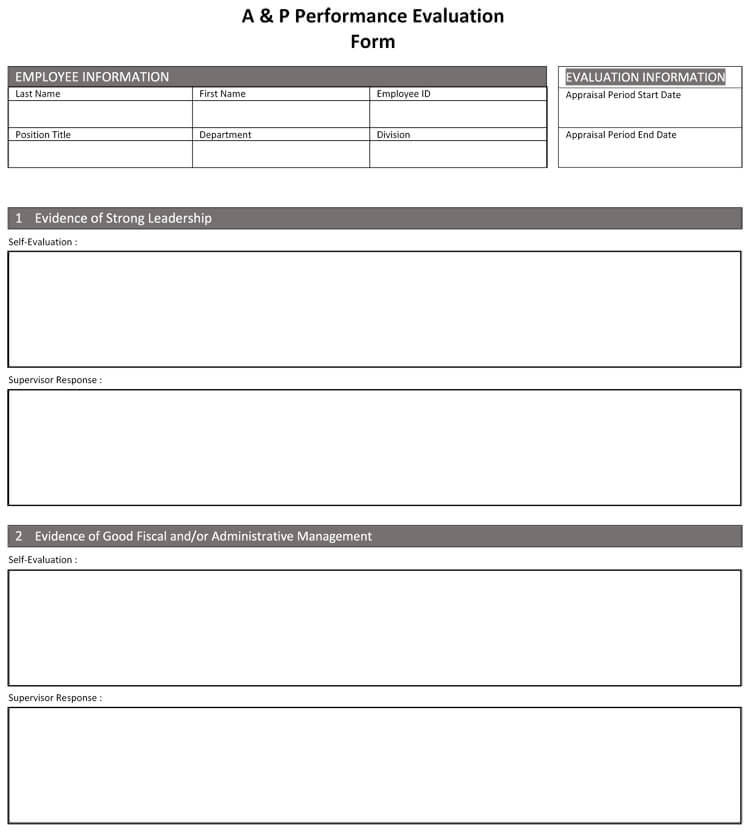

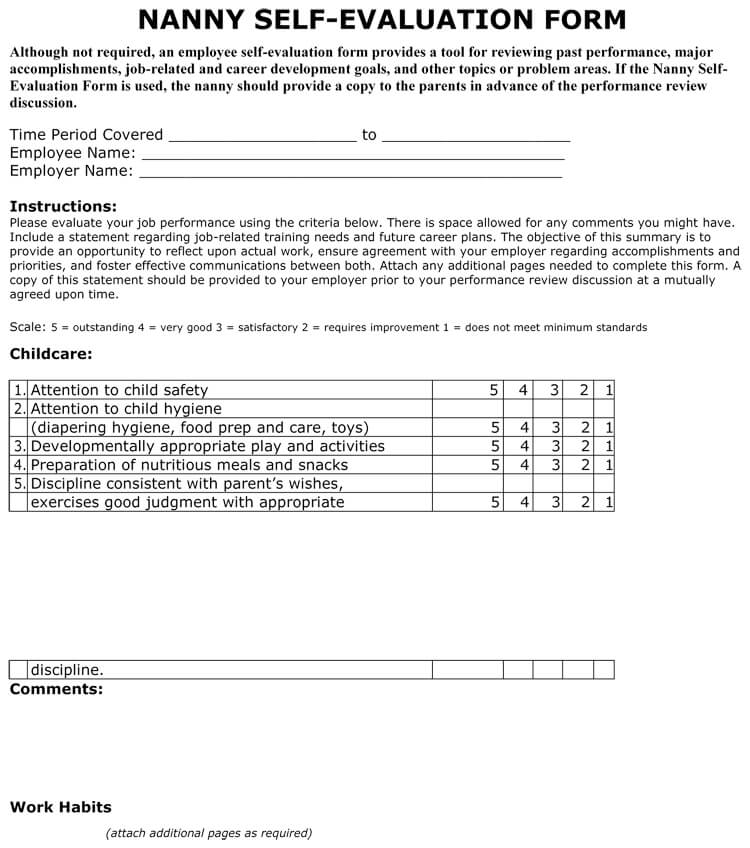
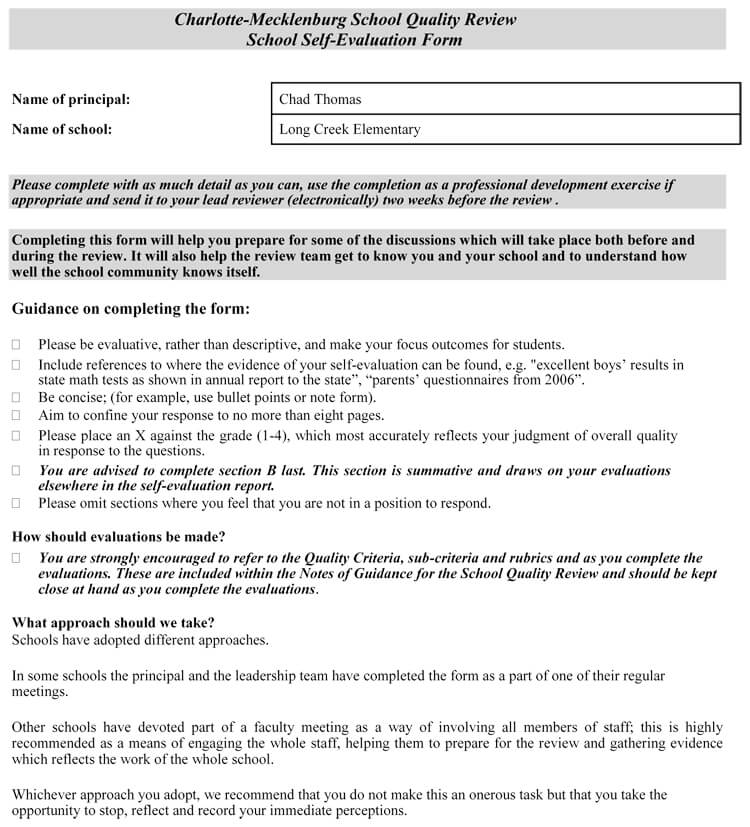
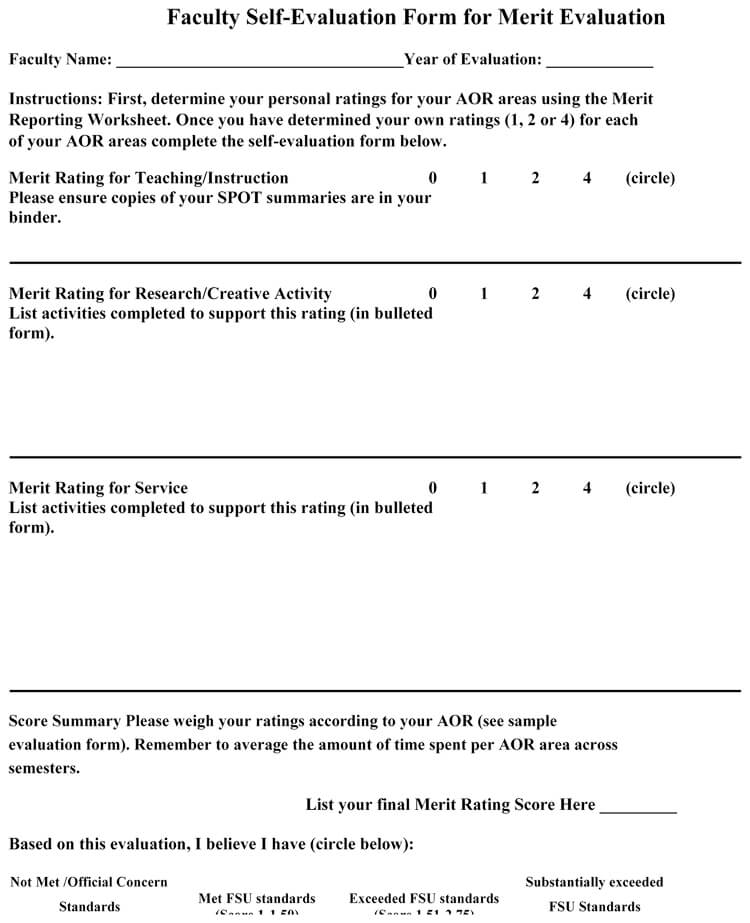

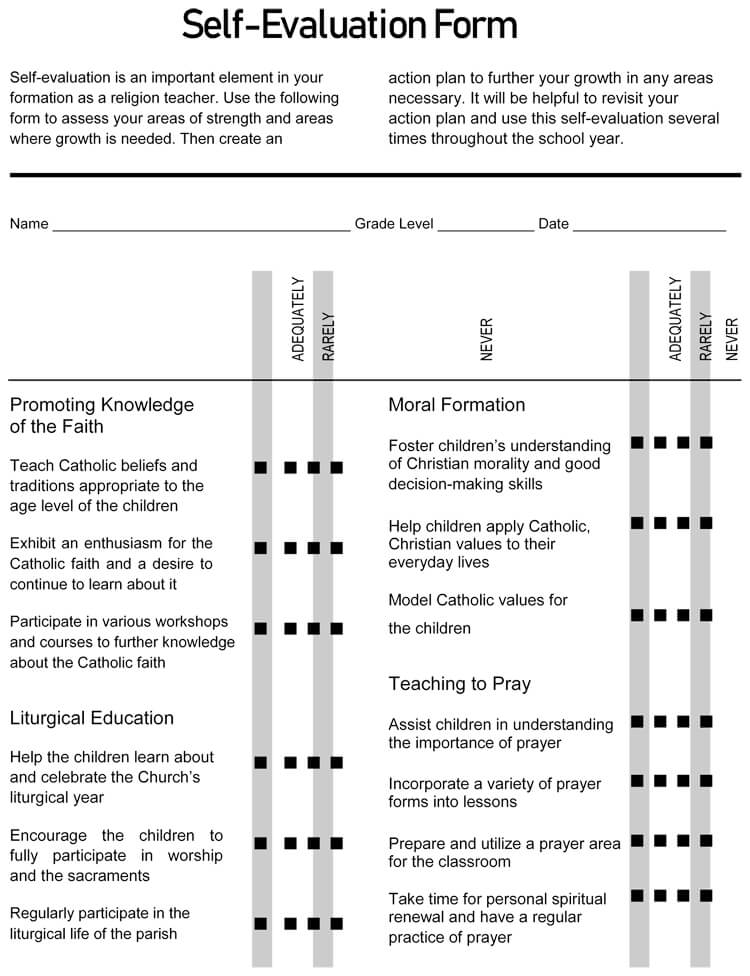
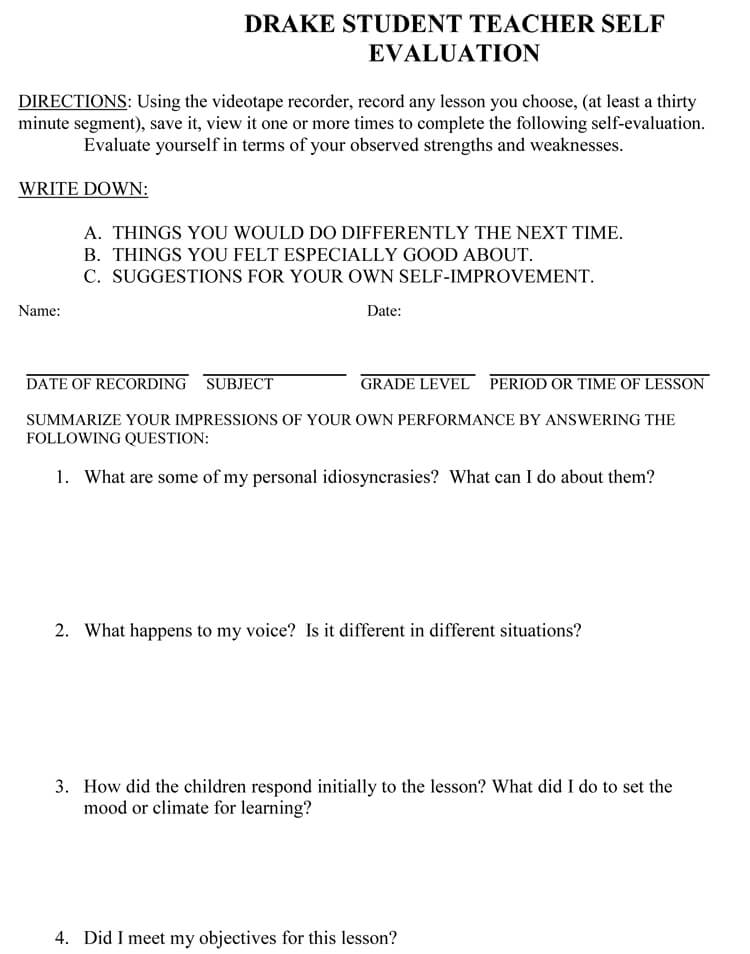
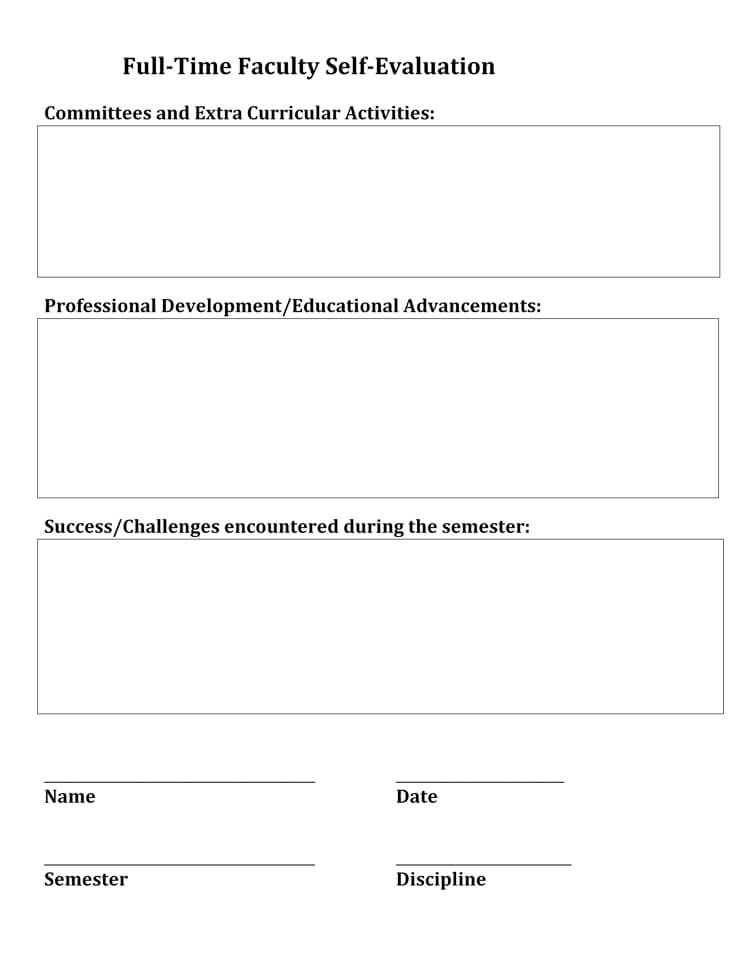
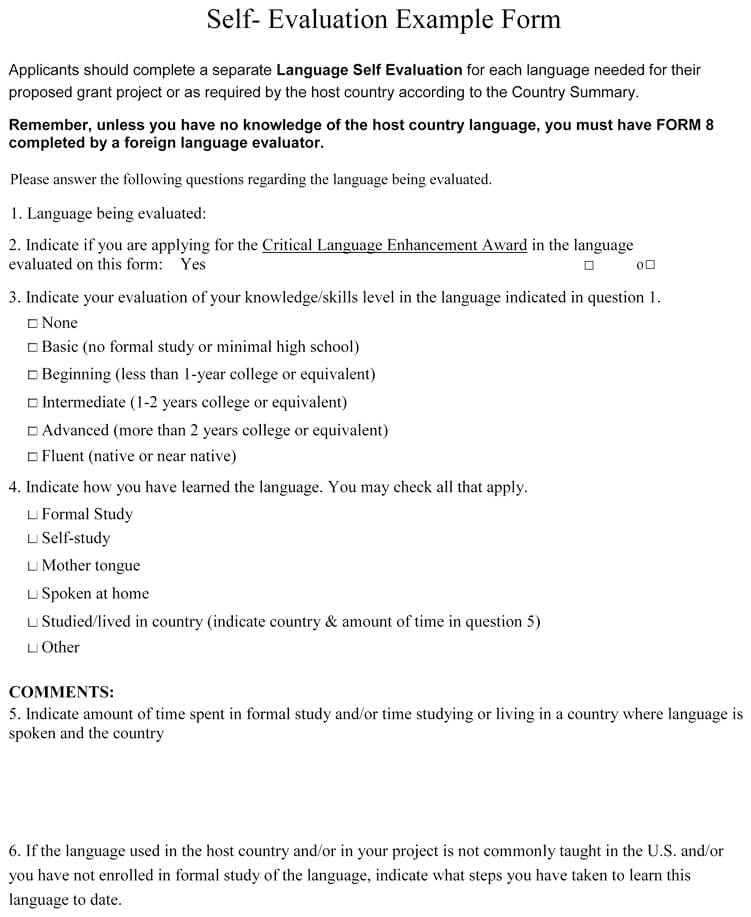
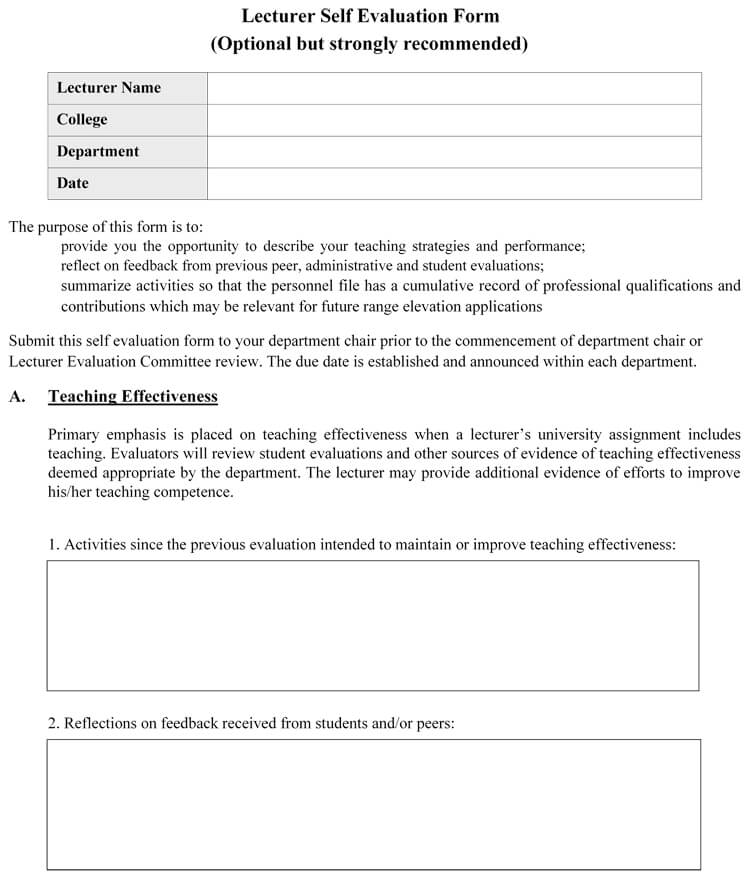

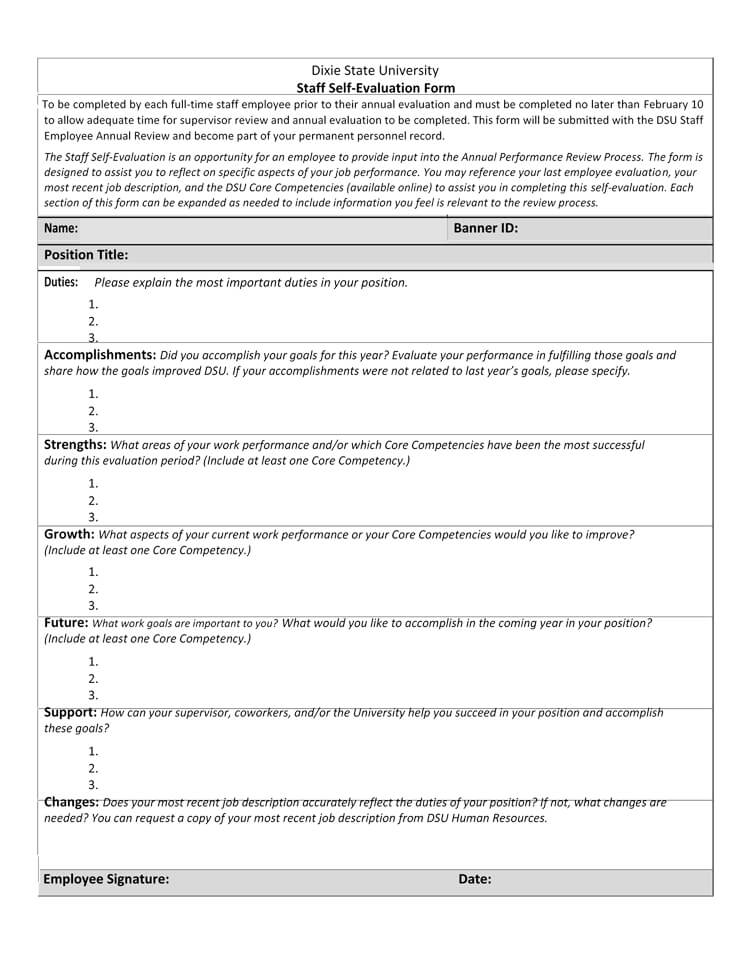
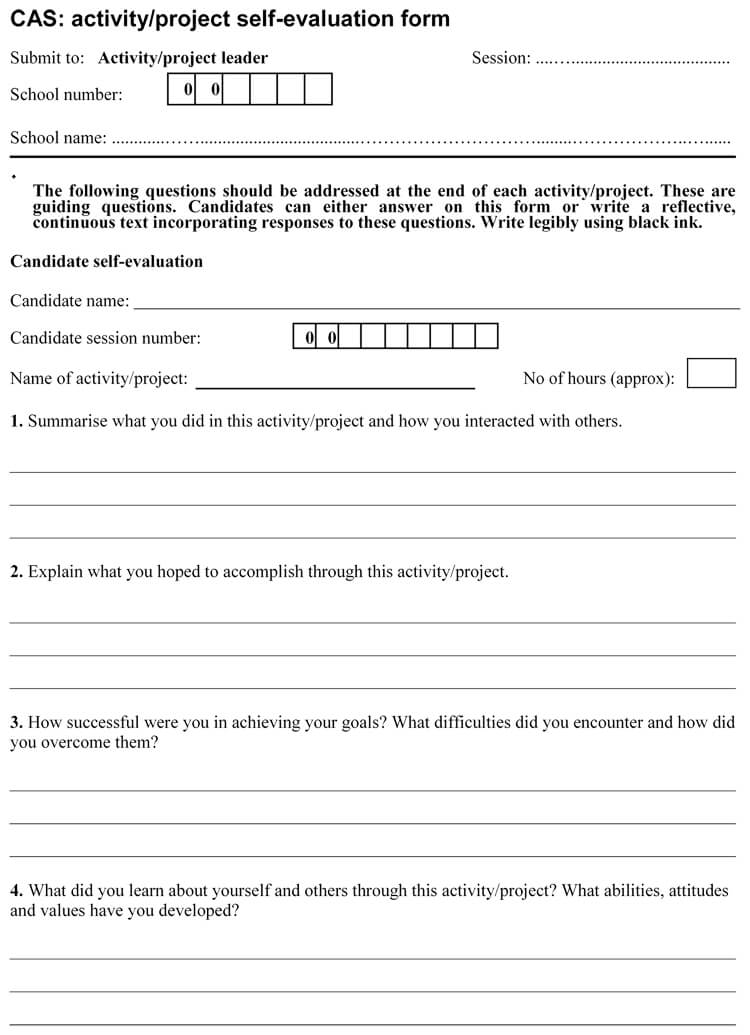
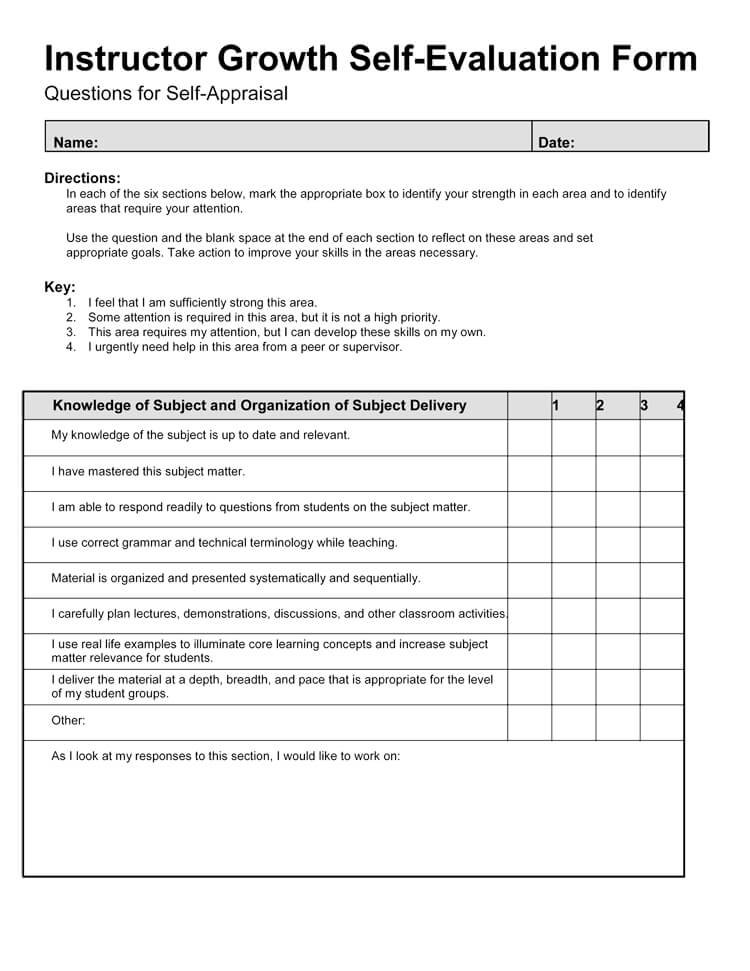

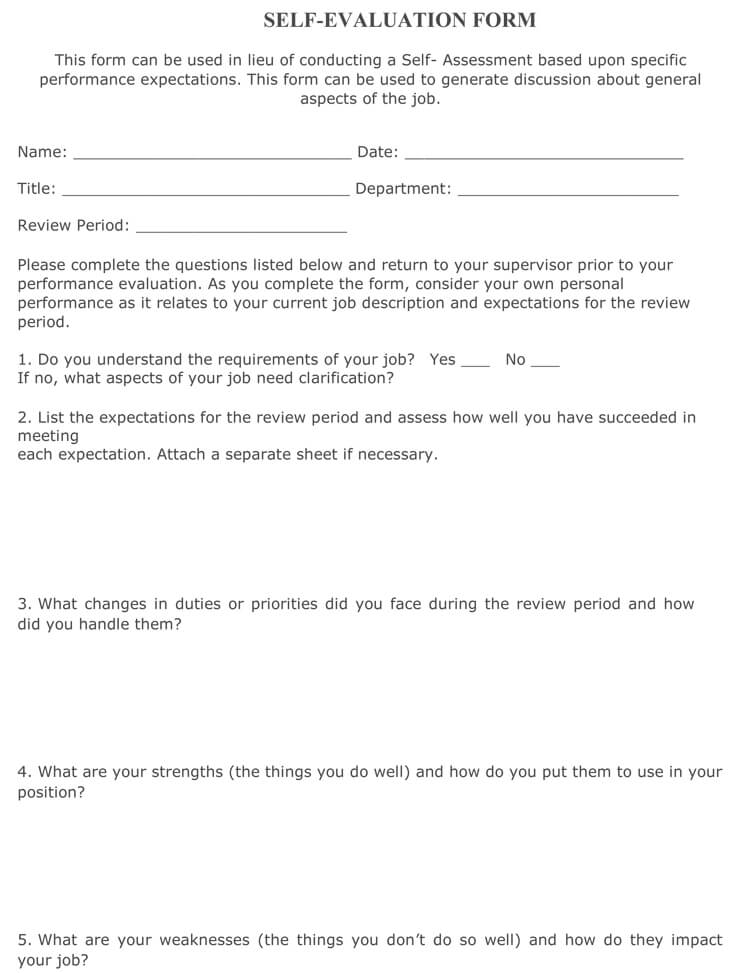

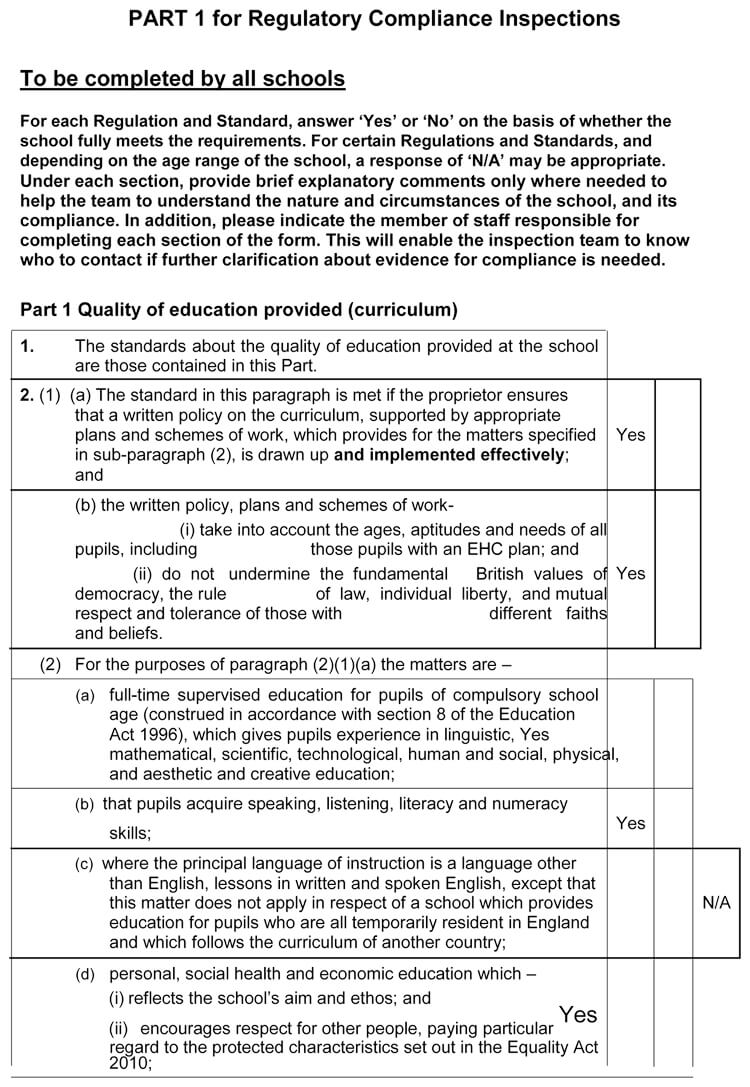
Writing a Self-Evaluation
Writing a professional and comprehensive self-evaluation is imperative. However, it is challenging for some employees to know where to start. It is advised that you should request that HR or employers issue clear expectations and guidelines on the type of self-assessment they would like. Once this is ascertained, an employee can use the procedure given below to produce an effective and efficient self-assessment.
Reflect yourself
In the beginning, the employees should reflect on themselves to assess what they did right and what they did wrong. Remember, admitting to having shortcomings is allowed in the corporate sector. It is not all the time that you meet deadlines. However, there are times when you can exceed expectations. When reflecting on yourself, the objective is to give the employer a clear idea of who the employee is.
Strengths
Strengths represent the things that an employee is good at and can utilize effectively to produce optimal results.
EXAMPLE
I am a competent programmer, an ability I use in a less formal capacity as a hobby and in a professional capacity.
I’m a social person and, as a result, very capable when it comes to sales and marketing.
Weaknesses
Employees should not refrain from mentioning some of their shortcomings. Employers know everyone has one or two inadequacies.
EXAMPLE
Give an honest review of the overall performance in 12 months.
Including them removes the perception of an ideal employee and introduces a more believable perspective.
EXAMPLE
Occasionally, I find myself being too strict with my team members. Colleagues have mentioned this, and I am surely working on improving to be more inclusive and understanding when it comes to decision-making.
Core values
The employee should state their core values and try to relate them to the organization’s core values. Core values are principles that you believe in and abide by.
EXAMPLE
I value honesty and respect, and I have tried to demonstrate this throughout my tenure at the company. I’m honest when airing my opinions and respect senior and subordinate staff members equally.
Accomplishments
An employee should be able to show remarkable things you have done over the past year. Accomplishments include projects that you completed on time, projects in which you played a major role in execution, additional tasks that you took, training, courses, other learning achievements, etc. Try to include accomplishments that the data can support. Data includes project names, dates, tasks, and results. Accomplishments that benefit your team or the employee should be given priority.
EXAMPLE
I spearheaded the Haven Guard Campaign, which took place between June and August 2020. As a team, we completed the campaign within the given timeframe and budget and delivered the required results. The campaign saw a 25% increase in sales within the third quarter.
PRO TIP
Highlight the challenges faced over the past 12 months and highlight what steps they have taken to overcome them.
Goals
Secondly, the employee should indicate any personal or professional goals they might have fulfilled or wish to fulfill. Sometimes the goals could have been set at the beginning of the year; this is an opportunity to check if they were met, exceeded, or if the employee fell short of the expectations. You can provide context, especially by stating why they were unable to achieve their goals.
EXAMPLE
I enrolled at Ridgewood University for a master’s degree in Project Planning, which I am to undertake as a part-time student. I hope to acquire relevant skills in project planning so that I can take on large projects in my line of work, which will boost the company’s clientele.
Also, the self-assessment should address future opportunities the employee is working towards. Employers want employees with ambitions who can benefit the organization both short-term and long-term.
Future goals can be both personal and professional (career-wise). Remember, growth is a very desirable aspect of the corporate world. Future opportunities can include promotions, an increased salary, or simply aspirations to outdo yourself.
EXAMPLE
I am a goal-oriented person, and for that reason, I believe in the company’s mission: to provide affordable housing for everyone. I intend to work towards using the position given to me by Beta Real Property agencies. As I climb the ladder in my career, I want to be more involved with designing houses.
Feedback
At the closing, the self-assessment should declare other colleague’s opinions on the employee. Most of the time, managers or supervisors evaluate their employees and raise concerns or commend their performance.
Do not rush to complete the self-evaluation. It is important to complete it keeping in mind the essential details about the performance.
The employee should include comments about their colleagues or supervisors and acknowledge their role in his or her performance during the past year.
EXAMPLE
My supervisor, Mr. Watson Smatts, has played a major role in ensuring that I adapt to my new job and motivating me to get better each day since I joined Scope Technologies. He was in charge of my orientation and introduced me to everyone I needed to know before commencing my duties.
Self-Evaluation Samples


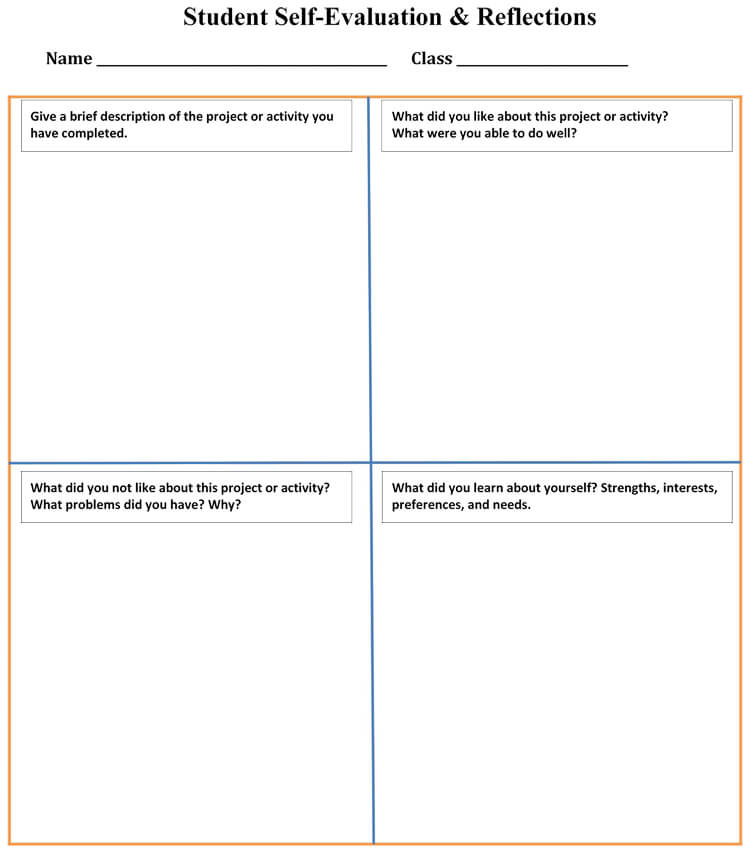
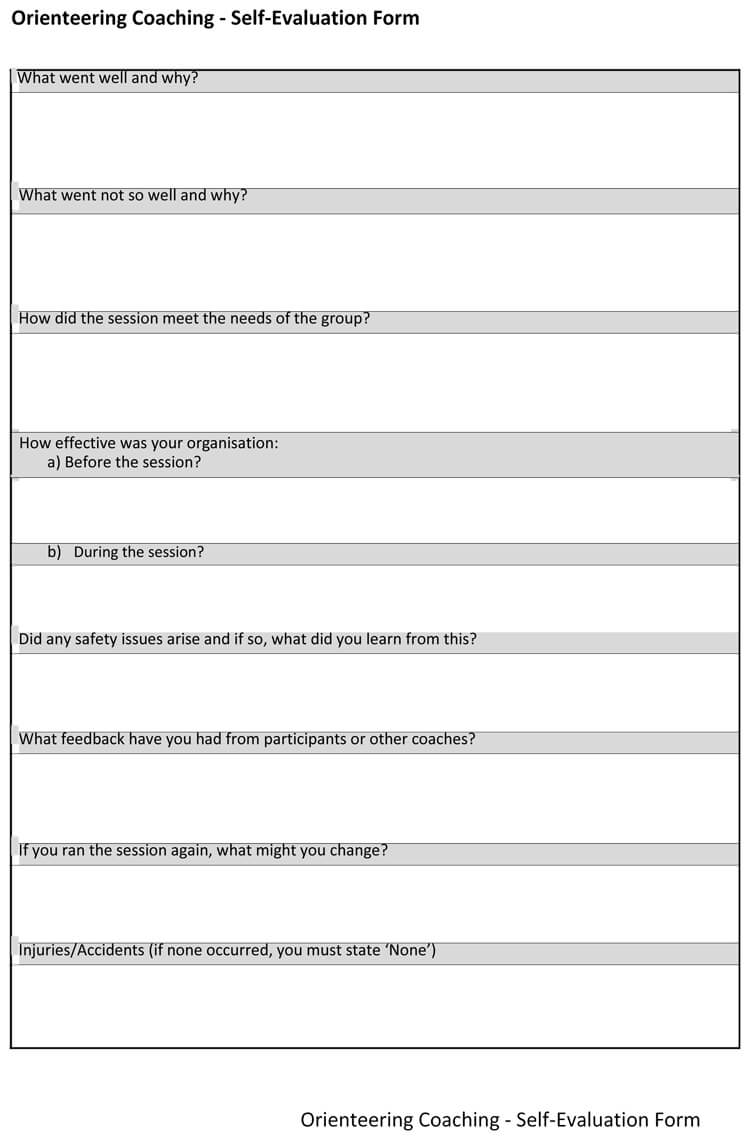
12 Self-Evaluation Example Statements
Given below are a few examples:
- There was an increase in sales of 30% when I was in charge of the XYZ area.
- I managed a team of interns for a period of four months.
- I coached an intern and was able to achieve a specific output.
- I was able to save $xyz during my supervision at XYZ area.
- I mentored an employee and his performance output increased by 40%.
- I reduced the company’s expenses in the marketing department by 20%.
- I trained three employees in the marketing department.
- I trained four employees in the human resources department.
- I trained a team of interns to learn sales strategies.
- I mentored the employees to learn customer relationship management.
- I reduced the expenses of the administration department by $xyz
- I started a course on teaching basic computer skills to a group of interns.
Tips for Effective Self-Evaluation
To improve self-evaluation, an employee can incorporate a few techniques. This way, the self-assessment improves in quality and efficiency. It might mean a promotion or an increased salary in some cases.
Below are things to consider when writing one.
- Include facts and figures. Supporting declarations with actual data improves the value of the assessment by providing criteria to measure an employee’s performance. Most will say, “Numbers typically speak for themselves.”
- Rationalize results: The information should be rational. When discussing successes, outline how they were achieved and who participated in or contributed to their success. Sometimes it is impossible to accomplish some things without extra help; it would be unrealistic to claim that was the case.
- Be proud. Self-evaluation is the employee’s chance to state what they accomplished in their work and how proud it made them feel. This should be reflected in the assessment. Any success worth mentioning should appear in a way that the employer understands the amount of effort or skill it took to accomplish it.
- Be honest and critical. Information given in the self-assessment should be true; untrue statements are misleading and compromise the employee’s reputation. Where mistakes were made, the employee should admit and outline what could have been done differently. Improvement requests should be acknowledged.
- Strive for growth: Throughout the assessment, the employee should aim to show his or her desire to make progress while at the same time improving the organization. It should show ambition.
- Review job description: An employee can use the assessment to review their job description and raise challenges faced when carrying out their assigned duties and other areas where adjustments should be made. You can suggest taking on more or fewer responsibilities.
- Make connections to organization goals. Try as much as possible to link accomplishments, skills, and attributes to the overall organizational goals. This increases the value of the employee in the company.
- Use the STAR method. The STAR method is a structured technique for answering questions. It is used when assessing how you would handle specific situations or problems in the workplace. STAR is an acronym for situation, task, action, and result. This method ensures clear and concise answers are given and supported by real-life examples and it should be used in a manner such that it is shown in the assessment when and how you used the STAR method while working as you answer self-evaluation questions as an employee.
- Define next steps: The employee should state the next steps they intend to take to improve their performance. This can include requests for training, mentoring, and guidance from the employer.
Conclusion
Writing a self-evaluation can be complex to some extent, given that you are expected to address their accomplishments and remain slightly critical at the same time. However, it is an essential part of employee management. Employers can use it as a basis for promotion and increasing salaries, and therefore, employees should actually be looking forward to it. Employees should not restrain themselves when discussing their success and accomplishments, as long as the information given is factual.
